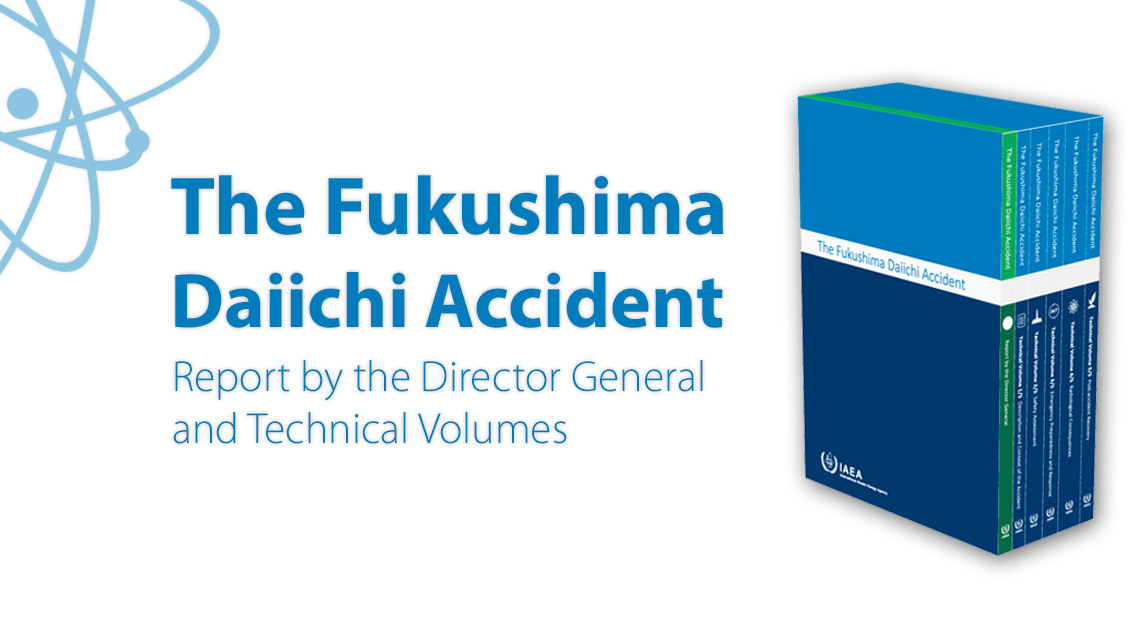IAEA Releases Director General’s Report on Fukushima Daiichi Accident
The IAEA Director General’s Report on the Fukushima Accident and
the five technical volumes distil and assemble lessons learned from the
accident and provide a knowledge base for the future.
The IAEA Director General’s Report on the Fukushima Daiichi Accident,
along with five technical volumes on this topic by international
experts, have just been publicly released. This publication comes ahead
of the Agency’s General Conference in September.
The report assesses the causes and consequences of the 11 March 2011 accident at the Fukushima Daiichi Nuclear Power Plant in Japan, triggered by a tsunami that followed a massive earthquake. It was the worst emergency at a nuclear power plant since the Chernobyl disaster in 1986.
“The report considers human, organizational and technical factors and aims to provide an understanding of what happened, and why, so that the necessary lessons learned can be acted upon by governments, regulators and nuclear power plant operators throughout the world,” IAEA Director General Yukiya Amano said in his Foreword to the Report. “There can be no grounds for complacency about nuclear safety in any country.”
The report and the technical volumes distil and assemble lessons learned from the accident and provide a knowledge base for the future. They consider the accident itself, emergency preparedness and response, radiological consequences of the accident, post-accident recovery and the activities of the IAEA since the accident. Measures taken, both in Japan and internationally, are examined. “Although nuclear safety remains the responsibility of each individual country, nuclear accidents can transcend national borders,” Mr Amano said in his foreword. “The Fukushima Daiichi accident underlined the vital importance of effective international cooperation. The IAEA is where most of that cooperation takes place. Our Member States adopted the IAEA Action Plan on Nuclear Safety a few months after the accident and have been implementing its far reaching provisions to improve global nuclear safety.”
Mr Amano had announced in 2012 that the IAEA would prepare an authoritative, factual and balanced assessment of the accident, addressing both its causes and consequences. The report is the result of an extensive collaboration that involved some 180 experts from 42 IAEA Member States and several international bodies.
The report and the technical volumes are accessible here. A brochure summarizing the main findings is available here.
The Director General’s Report in Arabic, French, Russian and Spanish is available here. The Chinese translation will be available later this week. The unofficial Japanese translation of the Foreword and the Executive summary of the Director General’s Report are available here. The full translation will be published in September.
The report assesses the causes and consequences of the 11 March 2011 accident at the Fukushima Daiichi Nuclear Power Plant in Japan, triggered by a tsunami that followed a massive earthquake. It was the worst emergency at a nuclear power plant since the Chernobyl disaster in 1986.
“The report considers human, organizational and technical factors and aims to provide an understanding of what happened, and why, so that the necessary lessons learned can be acted upon by governments, regulators and nuclear power plant operators throughout the world,” IAEA Director General Yukiya Amano said in his Foreword to the Report. “There can be no grounds for complacency about nuclear safety in any country.”
The report and the technical volumes distil and assemble lessons learned from the accident and provide a knowledge base for the future. They consider the accident itself, emergency preparedness and response, radiological consequences of the accident, post-accident recovery and the activities of the IAEA since the accident. Measures taken, both in Japan and internationally, are examined. “Although nuclear safety remains the responsibility of each individual country, nuclear accidents can transcend national borders,” Mr Amano said in his foreword. “The Fukushima Daiichi accident underlined the vital importance of effective international cooperation. The IAEA is where most of that cooperation takes place. Our Member States adopted the IAEA Action Plan on Nuclear Safety a few months after the accident and have been implementing its far reaching provisions to improve global nuclear safety.”
Mr Amano had announced in 2012 that the IAEA would prepare an authoritative, factual and balanced assessment of the accident, addressing both its causes and consequences. The report is the result of an extensive collaboration that involved some 180 experts from 42 IAEA Member States and several international bodies.
The report and the technical volumes are accessible here. A brochure summarizing the main findings is available here.
The Director General’s Report in Arabic, French, Russian and Spanish is available here. The Chinese translation will be available later this week. The unofficial Japanese translation of the Foreword and the Executive summary of the Director General’s Report are available here. The full translation will be published in September.


No comments:
Post a Comment